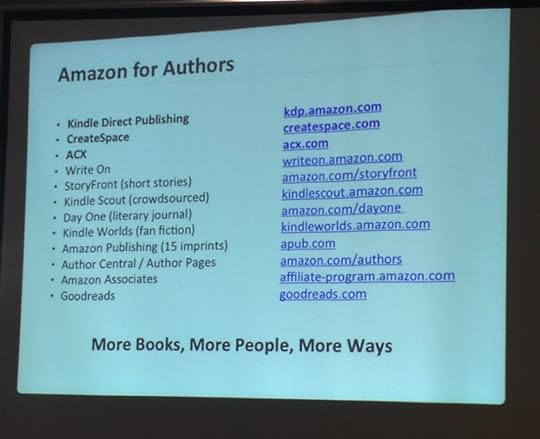Amy Shojai's Blog, page 91
May 20, 2015
SHOW AND TELL Cover Reveal!
 I am so excited to unveil this lovely, brooding and ominous cover to my next suspense/thriller SHOW AND TELL, the third book in the September Day series. I hope you like it as much as I do.
I am so excited to unveil this lovely, brooding and ominous cover to my next suspense/thriller SHOW AND TELL, the third book in the September Day series. I hope you like it as much as I do.
Because I’m superstitious, it feels a bit as though I’m responsible for the recent violent North Texas weather–sort of like those Night Gallery TV episodes where anything written on the enchanted typewriter comes true (yikes!). Now I’m scaring myself…in a good way. Do you do that, too? C’mon, you can tell me, I can keep a secret. 
In the previous books, animal behaviorist and trainer September along with her PTSD support/service dog Shadow have dealt with a freak blizzard in LOST AND FOUND, and then barely managed to escape a barn fire in HIDE AND SEEK. Now they have new challenges. This third book, SHOW AND TELL, again takes place over 24 hours in Heartland, Texas, this time with flash floods, hail and tornadoes, a rash of missing pets, and a dog fight ring that could spell the end for both September and Shadow.
Some of your fave characters return in this installment, including September’s trained Maine Coon cat Macy, and of course the hunky Detective Jeff Combs. Will September finally heal enough to risk her heart once again? If so, how will Shadow react? There are some newcomers (furry and human) that I hope you’ll also fall in love with. For those who have read the first two books, you’ll be pleased that SHOW AND TELL brings the story full circle, with some kid heroes this time. (Okay, that’s enough of a hint!).
Stay tuned in the near future for the launch of this round of NAME THAT DOG and NAME THAT CAT contest. Yep, you’ll get the chance to suggest names for some of the furry characters–maybe it will even be your dog or cat that appears in the book! Last time, the hotly contested vote kept us wondering … I’ll announce launch of the contest here on the blog and Facebook probably sometime in the next week or so, but my Sweet Peeps Pet Peeves Newsletter subscribers will get the announcement first. (They got the scoop on the cover reveal 2 days ago…just sayin…).
So don’t wait, go ahead and subscribe now to Pet Peeves. I’ve got some pretty nifty fun perks in mind for the launch of SHOW AND TELL and you don’t want to miss out!
I love hearing from you, so please share comments and questions. Do you have an ASK AMY question you’d like answered–click the banner, above. Be sure to visit my PetHealthyStore for paw-some products for your furry wonders! Stay up to date on all the latest just subscribe the blog, “like” me on Facebook, and get a FREE BOOK when you sign up for Pet Peeves newsletter. Stay up to date with the latest book give aways, kewl product offers, and appearances related to my THRILLERS WITH BITE!
May 18, 2015
RT Booklovers Virgin Loves The Experience!

STEAMPUNK PARTY! That’s me with my buddy Carole Nelson Douglas (author of the PAW-tastic Midnight Louie Mysteries and many others).
This month has been overwhelming with travel and events. April 25 at the Earth Day celebration I presented a fun Pet Peeves talk, and the following weekend attended the OWFI conference weekend where I co-presented three wonderful seminar presentations. May 9th was the Amazing Pet Expo in Dallas, where I paw-tographed books and served as the Emcee announcer at the event stage. Whew!
This Saturday join me for another Book Signing May 23rd at Dallas The Cat Connection! 14233 Inwood Rd. Dallas, TX, 75244, 866.386.6369 from 10:00am – 1:30pm. Samples of both Kitty Kaviar™ and a month’s supply Perfect Litter™ will be provided for all attendees, as well as gift certificates for purchases made in-store or on The Cat Connection website. Bring all your pet peeves questions for some advice and info.
But this past week had me nervous and excited all at once, with my first attendance at the RT (Romantic Times) Booklover’s Convention. I’d never gone before because I don’t write romance and (mistakenly) assumed the event was genre-specific. HOLY BOOKS, BATMAN! The event not only featured fantastic romance writers of every stripe, but authors and readers of every other genre also attended. Folks actually were interested in my September Day suspense/thriller series and intrigued by the dog viewpoint character.
Authors, bloggers, librarians, booksellers, aspiring authors, agents, editors, publishers, COVER MODELS–all attended. And the most important, fun and vital attendees of course were READERS. Avid readers. Readers who consume 3, 6, 10 books a week, form fan clubs to support favorite authors, and just generally are engaging, fun people. Love love loved this experience.
Kudos to the organizers, the volunteers and all the sponsors. Having organized (much smaller!) conventions, I can only imagine what went into this incredibly well run event. Next year it’s in Vegas…already penciled onto my calendar. So…time for your comments, what’s YOUR fav author/reader/writer event? Do tell!

Room keys, courtesy of AVON Books. And yes, there were about 20 cover models in attendance. *vbg*
At other “author signing” events it has not been unusual for me to have folks stop by and chat about their pets ask advice, but then say they “don’t read” and so pass on the books. Maybe they’re being polite–or maybe they really don’t read. That’s fine. But at the RT Convention, I found my people–everyone there loves books, reads books, and can’t wait to discover their next favorite book and author. BLISS! Scroll down to see a brief video of the author book signing of 500+ authors…that’s not a typo, there were at least 500 of us!
Did I mention the free books? Or the fantastic seminars (10+ each hour from whic to choose)? Or the “fan-girl” moments” at this event (thank goodness “stalking” is okay at these events). One of my regrets is I didn’t get a photo with (squeee!) Brenda Novak or get her to sign a book. We sat on the same THRILLER panel and we talked dogs–she has a Chow. I was in incredible company on the panel, with John Gilstrap, Andrew Peterson, Reavis Wortham (he lives in Frisco, near me!), and Anderson Harp. I was honored to be asked to sit on the panel, and gratified the audience seemed to enjoy our talk.
So here are a few pictures of the events I managed to attend. Oh, and next year, RT is in Vegas, baby! I am so there!

Structuring to Sell! Insider secrets for creating a story guaranteed to breakout big! Panelist Cat Clyne (Sourcebooks), Louise Fury (The Bent Agnecy), Nicole Resciniti (The Seymour Literary Agency), Whitney Ross (Tor Editor), Deb Werksman (Sourcebooks)

My view from the 17th floor down to the lobby of the Hyatt Regency (Dallas).

The Writing Voice–audience members read pages for critiques, a great sesson! Kevan Lyon (Marsal Lyon Literary Agency), Sarah Frantz Lyons (Riptide Publishing), Ruth Sternglantz (Bold Strokes Books), Abby Zidle (Gallery/Pocket).

Mark Coker of Smashwords offered an entire “Indie” track, great stuff as always.

Mark warns about the SNAKES out there eager to take advantage of unwary authors.

Self Publishing Panel

Self pub-panel, Sylvia Day and Karin Tabke

10 Concrete Ways to Make Release Day a Success: Claudia Gray, Cynthia Hand, Sophie Jordan, Jodi Meadows, Victoria Scott
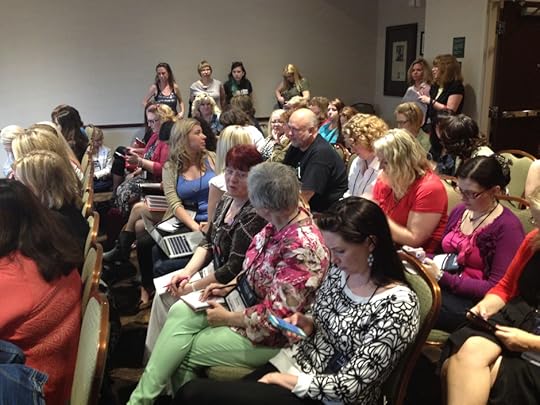
Standing room only in many sessions!

Romantic Fantasy: Jenna Black, Patricia Burroughs, Carole Nelson Douglas, Diana Pharaoh Francis

AMAZON! Neal Thompson (manager of author and Publishing Relations),

Urban Fantasy, What’s Next? Patricia Briggs, Diana Pharaoh Francis, Richelle Mead, Diana Rowland, Samantha Sommersby, Jeanne C. Stein, Chloe Neil, Nicole Peeler

AVON PRESENTS….A Night in Paris, mass book signing/give aways from Avon authors with treats and champagne.

Comfy shoes win out!

Carole rockin’ the spots & stripes!

Me with Kathryn Falk, the founder of RT Book Reviews (Fan Girl Moment!). Told her I might mug her for that jacket…

View in front of my autograph table…more behind me in the other direction, whew!
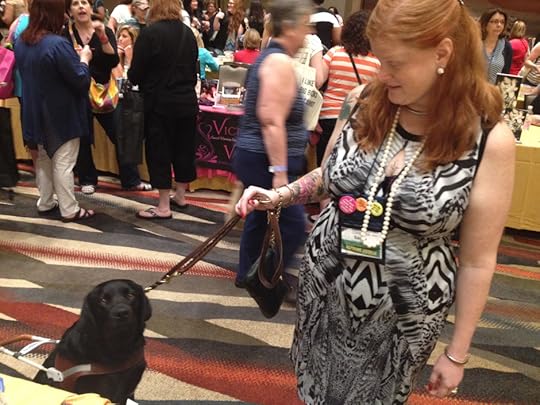
Some fans stopped by the table…but I think it was the K-9 Fat Free Treats bringing in the four-legged fellow!
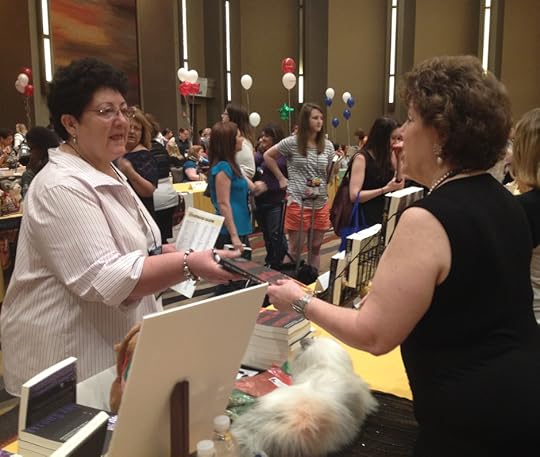
Yes, I actually sold a couple of books! Here with my new friend Nancy…
I love hearing from you, so please share comments and questions. Do you have an ASK AMY question you’d like answered–click the banner, above. Be sure to visit my PetHealthyStore for paw-some products for your furry wonders! Stay up to date on all the latest just subscribe the blog, “like” me on Facebook, and get a FREE BOOK when you sign up for Pet Peeves newsletter. Stay up to date with the latest book give aways, kewl product offers, and appearances related to my THRILLERS WITH BITE!
May 13, 2015
Matchmaking Tips for Cats & Dogs with #FoodShelterLove

Image courtesy of DepositPhotos.com

Image Courtesy of Hill’s Pet Products
This post is sponsored by Hill’s. I am being compensated for helping spread the word about Hill’s® Food, Shelter, & Love® Program, but Bling, Bitches & Blood Blog only shares information we feel is relevant to our readers. Hill’s Pet Nutrition, Inc. is not responsible for the content of this article.
This past weekend I was the Emcee at a pet expo in Dallas and was thrilled to offer advice to hundreds of pet lovers. There were dozens pet dogs in attendance as well as animal shelter adoption events featuring kittens, cats and dogs, with lots of dog rescue groups. I was pleasantly surprised that so many “dog” folks asked cat questions, because the truth is, LOTS of dog folks love cats, too, but aren’t sure how to make the combination work.
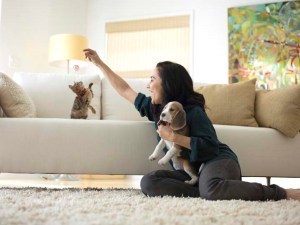
Image Courtesy of Hill’s Pet Products
The Hill’s Food, Shelter & Love® program has provided over $240 million worth of food to nearly 1,000 shelters, 365 days a year helping over 8 million pets find a new home…and counting. The program is designed to encourage loving individuals to support their local shelters by caring for and spending time with or even fostering local shelter pets. Mom-cats especially need a foster family for a quiet place to raise kittens until old enough for adoption.
Here’s where you come in. Foster a cat. Volunteer to help. And adopt a needy kitty–even if, or ESPECIALLY if you already love a dog. Here’s how!
CATS & DOGS MATCHMAKING TIPS
Easy-going dog breeds that don’t view smaller critters as LUNCH! make the best doggy friends for cats. Adult cats that have already lived with and been socialized to dogs also help speed up the introduction process. Kittens that are clueless may be more accepting of a new dog friend, especially if they’ve seen Mom-Cat be friendly with those weird-smelling bark machines.
Be aware that dogs and cats body language can mean contradictory things, so YOU need to interpret for them. Wagging dog tails invite you closer, but wagging cat tails warn you away. Just be sure your dog doesn’t get a face full of claws for being too nosy–that’s a terrible way to start a relationship.
Both pets need to be healthy. Cats need preventive care just like dogs do, and kitties that feel under the weather from illness or being spayed/neutered need time to recover before meeting the dog.
Savvy dog folks know that dog-to-dog intros work best on neutral territory–that’s outside your home, perhaps at a park. But cat intros for safety reasons need to happen INSIDE the house, so there are some clear differences in setting up the steps. You’ll find lots more how-to help for dealing with cat-dog challenges in my ComPETability(Cats-Dogs) book, but here are tips for getting started to build your very own peaceable kingdom between cats and dogs.
 HOW TO INTRODUCE CATS TO DOGS
HOW TO INTRODUCE CATS TO DOGSSequester the new kitty in a single room with all the necessary kitty accoutrements. Choose a room with a door that shuts completely such as second bedroom. Isolating the new cat tells your dog that only a small portion of the house has been invaded, not all the territory. It also gives your cat a safe retreat and place to cheek-rub and “claim” her territory. Cats will NOT be eager to meet new pets until they feel safe and comfy in their surroundings so give the cat a chance to find all the hiding spots, resting areas and safe perches in this one room for at least a week.
Expect cats to posture or hiss and dogs to sniff, whine, growl or bark on each side of the closed door. Feel encouraged once the barking and hissing fade, especially if the canine “play-bows” at the door or the pair play patty-cake-paws under the door. Magic whined…he wanted to meet the cat NOW NOW NOW!
After the kitty has been in the room alone for a few days, and any hisses or growls have faded, bring out something the new cat has scented, such as a plate of food where she just ate, and allow your dog smell it. THAT’LL bring on the wags! At my house, Magic gets to clean up the cat food bowls, but cat and kitten food has more protein and calories than dog food so too much could pack on the pudge. We have to be careful because Karma whats to eat Magic’s food, too.
Cats and dogs have very different nutritional needs and should eat only food that’s formulated for their specific needs. One lick here and there probably won’t hurt, though. (At least, that’s what Magic and Karma say!). The stress of introductions may cause some upset tummies or skin/coat issues, too. Hill’s® Science Diet® Adult Sensitive Stomach & Skin can help.
Once the hissing fades and the paw pats increase, allow your new cat to wander around the rest of the house while Rex stays outside in the yard. Don’t force anything, simply open the isolation room door and let Sheba explore and “map” the location of all the good hiding places and high perches to feel safe.
While Sheba explores one of the other rooms, let your dog check out the “safe room” to become more familiar with the new cat’s smells. Just be sure the litter box is out of dog sniffing/munching range (yuck!). Putting the kitty potty on a countertop may work well.
Next, install a baby gate in the isolation room so the pair can meet at their own speed, but through the safety of the barrier. We still have baby gates for the kitchen that allows the tiny 5-pound Seren-Kitty to come and go but keeps Magic and Karma inside (or outside) as needed.
Once Sheba feels comfortable navigating your house, and meetings through the baby gate has gone well, prepare for whisker-to-whisker meetings. Avoid fanfare. Put the dog on a leash, and then open the baby gate and watch what happens. Keep the pets away from halls, doorways or other closely confined spaces during initial meetings. An open room with lots of space reduces tension and gives the cat places to escape and you more control.
Feed both pets during this initial meeting, on opposite ends of a room to distract them and also help them associate FOOD with each others’ presence.
If the pets aren’t interested in food, engage them in play. Whoever your dog feels closest to should interact with the cat, so Rex sees that YOU accept the kitty and will be more willing to follow his beloved owner’s example.
Ensure feline perches are out of dog-sniffing range but within Sheba’s reach. This was very important for Seren-Kitty, and she still prefers second-story territory when Magic is around. Interrupt sniffing every now and then by calling the dog away or guiding him with the leash. Keep these initial meetings short—about five to ten minutes—so you don’t wear out the pets.
If they start to play, great! Allow play for a few minutes, and then break up the games and end the session on a good note so they want more of each other. Please be aware–unlike dogs, cats play SILENTLY, so if your cat starts to vocalize during interaction with the dog, the kitty isn’t happy. Separate them and try again later.
Continue to segregate the cat in her safe room whenever you cannot directly supervise the pair. Most cats can jump over or can squeeze through the baby gate and regulate interactions. Continue to offer more planned meetings for another week, monitoring the dog until he can control himself and respects the cat even when off leash.
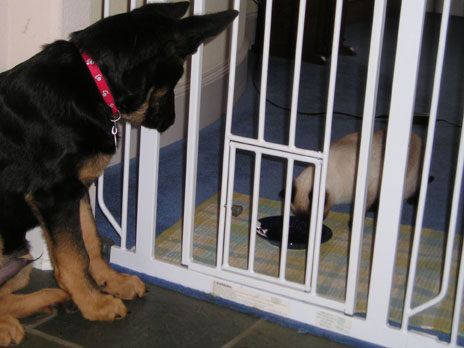
It took time, but eventually with some very-yummy-cat-treats Seren deigned to come within sight of the Magical-Pup. Image Copr. Amy Shojai, CABC
Nine years ago we introduced Magic-the-Puppy to Seren, it took her six months to feel comfortable enough to tell him off. Seren spent most of her time in my office on the second floor, and only came downstairs when the puppy slept. The only reason she lets Magic get close today is that at age 18 she can’t run away too well, so she resorts to hissing. Magic lets her bully him because from the very beginning he was taught that Seren was the boss.
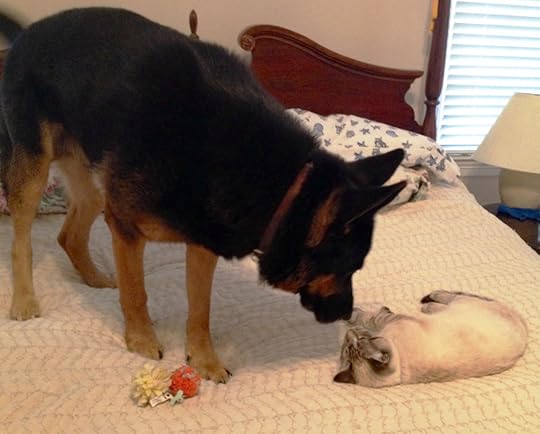
Magic alerted me that Karma-the-Stray needed our help, so it’s only natural they’re best buddies. Image Copr. Amy Shojai, CABC
But every cat and dog is different. When Karma came home, it was love at first sight between the kitten and German Shepherd. Magic finally had a cat that would (SWOON!) let him sniff kitty tail! Today the pair play chase and get each other into trouble and old-lady-Seren-Kitty stares with disdain from afar and kvetches.
So what are you waiting for? A shelter cat needs you–and your dog wants a kitty friend of his very own. Take it from Magical-Dawg, a cat can be a dog’s best pal.
I love hearing from you, so please share comments and questions. Do you have an ASK AMY question you’d like answered–click the banner, above. Stay up to date on all the latest just subscribe the blog, “like” me on Facebook, and get a FREE BOOK when you sign up for Pet Peeves newsletter. Stay up to date with the latest book give aways, and appearances related to my THRILLERS WITH BITE!
May 11, 2015
Weird Stuff Dogs Eat
 Owners fill bowls with nutritious food to keep dogs healthy. So why do dogs eat weird, disgusting and even dangerous stuff?
Owners fill bowls with nutritious food to keep dogs healthy. So why do dogs eat weird, disgusting and even dangerous stuff?
Dogs use their mouths the way we use our hands. They pick up objects and explore their world by mouthing, tasting, and chewing. That sometimes gets them into trouble if they swallow something they shouldn’t.
Eating Grass
As omnivores dogs benefit from eating vegetables or fruits. Even coyotes and wolves eat vegetable matter found in the stomach of prey, as well as roots, grasses and fruit. Dogs often beg for and enjoy snacks of raw vegetables like lettuce, green beans and carrots.
Most pet dogs occasionally eat grass, which may provide vitamins the dog craves, or he may simply like the taste. Dogs also eat grass to stimulate vomiting when he feels bad. Occasional grazing isn’t a cause for concern unless he turns it into an obsession or he gnaws poisonous houseplants.
Poop Eating Pups
Poop eating—called coprophagia—disgusts owners but this common habit comes naturally especially to puppies. Mom-dogs keep the nest clean by picking up after the babies, and youngsters typically copy-cat the behavior. Most pups outgrow the habit. But many dogs continue to snack on cat box “treats” or the leavings of cows and horses because—well—it must taste good to them. Also, the cat, horse or other critter may not have completely digested all the nutrients so the dog relishes giving the poop another chance.
Eating Dirt
We’re not sure why dogs eat dirt but many seem to relish certain types of soil. Some wild animals target clay-like soils that naturally absorb toxins, and others are known to eat mineral-rich dirt to supplement their diet.
For dogs, scent probably plays a role. Perhaps another animal has “marked” that spot of dirt, so the dog tastes to get a better “read” on the message. Dogs seem to preferentially target specific types or locations of dirt, too. Eating too much dirt can plug up doggy plumbing but an occasional taste probably isn’t worry-worthy.
Eating “Stuff”
Dogs swallow an amazing range of nonedible items and it goes beyond eating the kid’s homework. The behavior is called pica, and can be an accident when the dog gulps down a piece of a toy. Pica may be purposeful if the object proves too tempting—baby bottle nipples that smell of milk, used tampons, and grease-smeared foil or turkey-basted string prove irresistible to dogs.
The most common item is socks, followed by underwear, panty hose, rocks, balls, chew toys, bones, hair ties/ribbons, and sticks. Most items tend to be owner-scented objects and dirty diapers are another favorite—it combines the attraction of poop-eating.
But some dogs seem drawn to such weird items as pagers, hearing aids, drywall, batteries, rubber bands, or anything (including sand!) with bacon grease poured on it. Dogs develop bad habits out of boredom, stress or even obsessive-compulsive behaviors and turn into garbage disposals. These dogs chew and suck down rocks and sticks.
Poke The Poop
In most cases small objects pass harmlessly through the body and end up on the lawn within 24-72 hours. Get a stick and wear gloves to poke through the doggy droppings to be sure he’s gotten rid of the object. Feeding your dog a meal can turn on digestive juices, cushion the item, and help move it along.
But sharp objects can cut, heavy stones can plug the system, and string-type material (thread, ribbon, Easter grass, tape from a cassette) can cut and strangle the intestines. Swallowed coins, batteries or other metal objects can poison pets once they react with digestive juices. String hanging out of either end of the dog shouldn’t be touched, or you risk hurting him worse.
If you’ve seen the pet swallow something he shouldn’t but it doesn’t pass, or the dog begins vomiting, retching without result, won’t eat, looks or behaves distressed, or coughs repeatedly, seek help. It may require X-rays to figure out what’s wrong on the inside of your pet, and surgery to get it out.
Most puppies outgrow indiscriminate munching. But if your dog vacuums up anything that hits the floor, pet proof doggy toys as well as your home. It could save you veterinary bills—and your pet’s life.
I love hearing from you, so please share comments and questions. Do you have an ASK AMY question you’d like answered–lick the banner, above. Be sure to visit my PetHealthyStore for paw-some products for your furry wonders! Stay up to date on all the latest just subscribe the blog, “like” me on Facebook, and get a FREE BOOK when you sign up for Pet Peeves newsletter. Stay up to date with the latest book give aways, kewl product offers, and appearances related to my THRILLERS WITH BITE!
May 7, 2015
Paw-some OWFI Conference & Amazing Pet Expo
I’m traveling nearly every weekend this month, and it’s hard to keep straight where I go next. I’m only now getting caught up with last weekend’s awesome OWFI Conference, and (BAD AMY!) realized I don’t have nearly as many pictures as I hoped. So for some of these, I’ve borrowed from various folks kind enough to tag me on my Facebook page…and forgive me for not mentioning everyone. I know that I’ll forget some folks.
I’m an OWFI Honorary Life Member (yes, I’ve been going to this con every year since 1992), and have run the contest and even organized the 40th Anniversary Conference as president. So I know how much hard work it takes, and how many volunteers make things happen. Kudos to one and all.
There were many highlights of the event. I got to present with my fav co-writer EVAH, Frank Steele, in three seminars, and we got to share details about our playwright experience, collaboration, and even writing in “animal” voice. Stay tuned in case you missed them, because the powerpoint presentations will eventually be uploaded here to the blog for on-demand sessions.

My partner in play-writing, Frank Steele.
Just for fun, if you’re in a play-ful mood, I finally got the video trailer done of KURVES, THE MUSICAL and you can watch it on this page. You’ll hear me sing on the video, too (urk!).
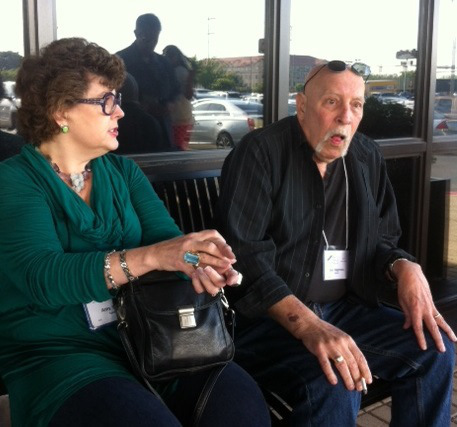 I got to meet Les Edgerton and we spent quite a lot of time in his “office” (aka the smoker’s bench) in between sessions. Anyone reading this–he is a fantastic speaker and writing teacher, with great stories and even better books. YOU NEED HIM as a speaker on your next writer con faculty! Just saying…
I got to meet Les Edgerton and we spent quite a lot of time in his “office” (aka the smoker’s bench) in between sessions. Anyone reading this–he is a fantastic speaker and writing teacher, with great stories and even better books. YOU NEED HIM as a speaker on your next writer con faculty! Just saying…
 Thanks to Jen Nipps for sending me a photo of one of the presentations. D’ya think I’m wearing enough bling?
Thanks to Jen Nipps for sending me a photo of one of the presentations. D’ya think I’m wearing enough bling?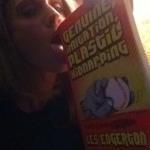 My new friend Becky Franklin has some fun and innovative ways to review and promote books! She’ll read your book and if she truly likes it, you’ll get a Selfie of her and the “Lick Of Love” …obviously she has great taste! (Pun intended…) Meeting her was a highlight of the OWFI conference!
My new friend Becky Franklin has some fun and innovative ways to review and promote books! She’ll read your book and if she truly likes it, you’ll get a Selfie of her and the “Lick Of Love” …obviously she has great taste! (Pun intended…) Meeting her was a highlight of the OWFI conference! Becky sent this photo, too. She has as couple of doggies and plans to train them to help fetch items for her that are out of reach when she’s in her wheelchair, so I paw-tographed a copy of one of my books for her. Not sure what’s going on with that book-party, but I think Les put her up to it. Below, that’s Becky with Frank.
Becky sent this photo, too. She has as couple of doggies and plans to train them to help fetch items for her that are out of reach when she’s in her wheelchair, so I paw-tographed a copy of one of my books for her. Not sure what’s going on with that book-party, but I think Les put her up to it. Below, that’s Becky with Frank.
AMY’S IN DALLAS!
This month, I’m traveling and speaking/signing books nearly every weekend. So I wanted to give a shout out to the Amazing Pet Expo in Dallas this Saturday. Last year, the event drew a crowd of over 11,000 people, highlighting the impact that the Pet Expo continues to have on the Greater Dallas Area and organizers anticipate another packed event in 2015.
Over 20 local rescue organizations as well as over 100 adoptable pets will be on-hand at the event and looking for new forever homes. Several of these organizations are able to participate at a discounted or fully underwritten rate thanks in large part to corporate partners such as Petfinder.com, Banfield Pet Hospital, Blue Buffalo and Plato Pet Treats.
Lon Hodge and and his service dog Gander will be available all day to meet and greet fans, take photos, and talk about the importance of service animals in military and veteran members’ everyday lives. I was privileged to be in a Google Hangout with Lon recently and will see him the end of this month again at the big Blogpaws event in Nashville.
My friend Arden Moore moved from California to the area and we’ve not had a chance to get together. But she’ll be there, too, presenting about PET FIRST AID and also signing her great pet care books at booth 404. I think she’ll also be recording shows for her PetLifeRadio.com show OH, BEHAVE! Oh…and she’ll have Casey, her demo kitty there (think “Karma-Kat” in orange, LOL!) and a doggy friend, too.
“We’re so excited to return to the Dallas pet community,” says Ethan Barnett, Vice President of Community Partnerships for Amazing Pet Expos, “A huge part of our initiative is to help people become better pet companions, and we look forward to meeting all the amazing pet parents in Dallas and to making an impact in pets lives across the region. Whether you would like to shop, learn, play or adopt – you can do any one of those at the 2015 Dallas Pet Expo.”
PET EXPO/DALLAS is Saturday May 9, 2015 from 10:00 – 6:00, I’ll be at Dallas Market Hall at the Event Stage. It’ll be a fun all-day extravaganza, with book signings (I’ll have mine there!) and I’ll be the EMCEE on the stage announcing pet-centric events throughout the day, and signing books at the AdoptAShelter.com booth #407. You can bring your pet, too. Learn more at this link.
Please stop by and say HOWDY!
I love hearing from you, so please share comments and questions. Do you have an ASK AMY question you’d like answered–click the banner, above. Be sure to visit my PetHealthyStore for paw-some products for your furry wonders! Stay up to date on all the latest just subscribe the blog, “like” me on Facebook, and get a FREE BOOK when you sign up for Pet Peeves newsletter. Stay up to date with the latest book give aways, kewl product offers, and appearances related to my THRILLERS WITH BITE!
May 6, 2015
Scaredy Cat? 7 Tips to Ease the Angst

Image courtesy of DepositPhotos.com
Does your new kitten hide under the bed? Do your adult cats disappear when visitors ring the doorbell? Does the new puppy send kitty into hiss-terics? Learning why cats act scared helps you know how to avoid “fright night” triggers.
Why Cats Get Scared
Scaredy cats react with fear to unfamiliar people, places or situations, because if they haven’t had a good experience—so they assume the worst. Many kittens are clueless but as the cat matures, this “stranger danger” behavior protects kitties so they don’t walk up to hungry critters, dogs or people.
Cats identify friends by smell. But if they haven’t cheek-rubbed, groomed or slept together, strangers “smell funny” and therefore are suspect. Kitties only used to women may fear men with lower voices or with beards. Kids move and sound differently than adults and can be scary to cats. New dogs or cats often intimidate them, especially when the kitten has never seen a dog before!
A strange environment turns up kitty nerves because the boogyman might lurk in some unknown spot. Your cat won’t know the escape routes or safety zones, so fear becomes the default emotion.
Fearful cats that can’t run away may use aggression to protect themselves from perceived danger. A panic attack shuts down the brain so that the cat literally can’t think and instinctive fight-or-flight takes over. Use these tips to transform shivers to purrs.

Scared Siberian kitten. Image courtesy of DepositPhotos.com
7 Confidence Boosters to Reduce Feline Fear
Socialize Kittens. The prime socialization period for kittens is two-to-seven weeks of age. When you first adopt your kitten, expose youngsters to happy, positive experiences with a variety of strangers and other pets. That helps them learn that other people, places, and critters can be fun and not scary.
Offer Safe Retreats. Let the cat or kitten hide. Forcing interactions just makes the fear worse. Give time for the pet to cheek rub and become familiar with the new place. Cats prefer to hide in dark places where they can’t easily be seen, and inaccessible places they can’t be reached and/or can most easily defend so offer some neat options.
Use Play. When cats engage in fun games their brains can’t be happy and scared at the same time. A long distance interactive toy like fishing-pole lures teach cats you are fun to be around, but without having to get too close. You can even sit on top of the bed, and “tease” the cat that hides underneath without scaring the kitty by reaching under to grab him.
Offer Treats. If your cat loves food, offer smelly treats to diffuse the angst. Have visitors drop or toss treats when they arrive at the door, so the doorbell means “food” instead of “stranger danger.”
Get On Kitty’s Level. To a little cat, humans look imposing especially when we stare, follow the cat, and try to pet them. Just think of that giant-size hand coming down toward your head! Instead, sit on the floor, and ignore the cat—no eye contact which can be intimidating—and lure the kitten or cat with treats or a toy. Let the cat approach and control the interaction.
Diffuse Cat Fights. Fearful cats act like they’re wearing a “kick me” sign so other felines pick on the victim. Offer lots of cat trees and hiding spots for escapes, multiple litter boxes and feeding stations so they don’t have to argue or interact too closely. Try putting a bell on the aggressor-cat’s collar to give the fearful cat warning to get out of the way.
“Doctor” The Angst. Feliway, a synthetic feline facial pheromone, comes as a plug-in or spray that helps ease tensions related to territorial and environmental stress. Rescue Remedy is a natural remedy that helps some anxious cats when added to the water. You can find Feliway and Rescue Remedy at pet product stores. In severe cases, your veterinarian may prescribe anti-anxiety medications for the scared cat.
Some cats are simply less touchy-feely than others and never will be lap snugglers. These tips won’t turn all cats into social butterflies, but they can help dial down the fear. Refer to one of the books, click the covers above, for more specific tips about dealing with feline fear. Patience and giving your cat time to learn she has nothing to fear goes a long way toward turning up the purrs.
Are your kitties Christopher Columbus Cats ready to explore the world, or Shrinking Violets? How did you manage the fear? Do tell!
I love hearing from you, so please share comments and questions. Do you have an ASK AMY question you’d like answered–click the banner, above. Be sure to visit my PetHealthyStore for paw-some products for your furry wonders! Stay up to date on all the latest just subscribe the blog, “like” me on Facebook, and get a FREE BOOK when you sign up for Pet Peeves newsletter. Stay up to date with the latest book give aways, kewl product offers, and appearances related to my THRILLERS WITH BITE!
May 4, 2015
Stages of Puppy Development: Birth to Two Years

Newborn puppy yawning. Images courtesy of DepositPhotos.com
Today I’m celebrating a new cover for my SQUEEE!!! book, COMPLETE PUPPY CARE. I’ve included an excerpt, below, of one of the most popular topics: puppy development stages, birth to two years. Dogs are considered puppies from birth to one year of age and go through several puppy stages and development periods. However, each dog develops differently, with smaller dogs tending to mature earlier and some large breeds not physically mature before they are two years old.
Newborn puppiesvary in size depending on the breed; tiny dogs like the Chihuahua produce puppies sized about four inches long, while giant breed newborns like Great Dane puppies may be twice that size. Rate of puppy development also varies from breed to breed. For instance, Cocker Spaniel puppies open their eyes sooner than Fox Terrier puppies, and Basenji puppies develop teeth earlier than Shetland Sheepdog puppies. However, no matter the breed, all puppies are born totally dependent on the momma dog, technically called the bitch.
Newborns
At birth, puppies are blind, deaf and toothless, unable to regulate body temperature, or even urinate or defecate on their own. Puppies depend on their mother and littermates for warmth, huddling in cozy piles to conserve body temperature. A puppy separated from this warm furry nest can quickly die from hypothermia—low body temperature. Cold, lonely puppies cry loudly to alert Mom to their predicament.
Puppies first experience the sensation of being petted when washed by their mother’s stroking tongue. The bitch licks her babies all over to keep them and the nest clean, and also to stimulate them to defecate and urinate.
Neonatal Period: Birth to Two Weeks
From birth, puppies are able to use their sense of smell and touch, which helps them root about the nest to find their mother’s scent-marked breasts. The first milk the mother produces, called colostrum, is rich in antibodies that provide passive immunity and help protect the babies from disease during these early weeks of life.
For the first two weeks of life, puppies sleep nearly 90 percent of the time, spending their awake time nursing. All their energy is funneled into growing, and birth weight doubles the first week. Newborns aren’t able to support their weight, and crawl about with paddling motions of their front legs. The limited locomotion provides the exercise that develops muscles and coordination, and soon the puppies are crawling over and around each other and their mother.
 Transitional Period: Week Two-to-Four
Transitional Period: Week Two-to-FourThe second week of life brings great changes for the puppy. Ears and eyes sealed since birth begin to open during this period, ears at about two weeks and eyelids between ten to 16 days. This gives the furry babies a new sense of their world. They learn what their mother and other dogs look and sound like, and begin to expand their own vocabulary from grunts and mews to yelps, whines and barks. Puppies generally stand by day 15 and take their first wobbly walk by day 21.
By age three weeks, puppy development advances from the neonatal period to the transitional period. This is a time of rapid physical and sensory development, during which the puppies go from total dependence on Mom to a bit of independence. They begin to play with their littermates, learn about their environment and canine society, and begin sampling food from Mom’s bowl. Puppy teeth begin to erupt until all the baby teeth are in by about five to six weeks of age. Puppies can control their need to potty by this age, and begin moving away from sleeping quarters to eliminate.
Socialization Period: Week Four-to-Twelve
Following the transitional phase, puppies enter the socialization period at the end of the third week of life; it lasts until about week ten. It is during this socialization period that interaction with others increases, and puppies form attachments they will remember the rest of their life. The most critical period–age six to eight weeks–is when puppies most easily learn to accept others as a part of their family.
Beginning at four weeks of age, the bitch’s milk production begins to slow down just as the puppies’ energy needs increase. As the mother dog slowly weans her babies from nursing, they begin sampling solid food in earnest.
The environmental stimulation impacts your puppy’s rate of mental development during this time. The puppy brain waves look that of an adult dog by about the 50th day, but he’s not yet programmed–that’s your job, and the job of his mom and siblings. Weaning typically is complete by week eight.

12 week old Newfoundland puppy
Week Eight-to-Twelve
Puppies often go through a “fear period” during this time. Instead of meeting new or familiar people and objects with curiosity, they react with fearfulness. Anything that frightens them at this age may have a lasting impact so take care that the baby isn’t overstimulated with too many changes or challenges at one time. That doesn’t mean your pup will grow up to be a scaredy-cat; it’s simply a normal part of development where pups learn to be more cautious. Careful socialization during this period helps counter fear reactions.
Puppies may be placed in new homes once they are eating well on their own. However, they will be better adjusted and make better pets by staying and interacting with littermates and the Mom-dog until they are at least eight weeks old–older generally is better. Interacting with siblings and Mom help teach bite inhibition, how to understand and react to normal canine communication, and their place in doggy society. Puppies tend to make transitions from one environment to another more easily at this age, too.
Juvenile Period
The juvenile puppy period generally begins at age ten weeks, and lasts until puberty and the onset of sexual maturity. It is during this period that puppies begin to learn the consequences of behavior, and determine what is most appropriate to certain circumstances.
Puppies at this age have boundless curiosity, exasperating stubbornness, and enthusiastic affection. Expect your puppy to get into everything, and you won’t be disappointed. This is an ideal time to begin training.
Nearly every waking moment is spent in play, which is not only great fun for the babies, but is great practice for canine life. Puppies learn how to do important dog activities like chasing and running, pawing, biting and fighting. Social skills and canine etiquette are learned by interaction with littermates and Mom. Puppies learn to inhibit their bite when they are bitten by each other, and learn canine language. Through play, they practice dominant and submissive postures, and prepare for life in the world.
10-16 weeks: Juvenile Delinquent Pups
Puppies test their boundaries during this period that lasts anywhere from a few days to several weeks. These dogs challenge owners to see who calls the shots, seem to “forget” any training they’ve learned, and act like rebellious teenagers.
Some of this has to do with teething. Pups lose baby teeth starting about three months of age. There can be discomfort as the permanent teeth erupt and puppies tend to chew more on anything and everything to relieve the pain.
Delinquent behavior also may be influenced by hormones. Unlike many other species, a male puppy’s testosterone level from age four-to-ten months may be up to five times higher than an adult dog’s. That’s so the adult canines recognizes he’s a juvenile and needs “schooling” in the ways of dogs—they make sure to knock him down a peg and teach manners before he gets too big for his furry britches.
But even pups that have been spayed and neutered prior to this can develop the “oh yeah, MAKE me!” attitude. Owners who have done everything right may still experience this difficult, frustrating phase. Grit your teeth, keep him on leash and under control, offer consistent, patient and humane training, and tell yourself, “He’s testing me, it’ll get better.” Because it will.

6 month old Whippet.
Four to Six Months
Pups grow so quickly during this period you may notice changes every single day. Not only may your pup test and challenge you, this is the time frame puppies also figure out where they stand with other pets in the group. Some squabbling and play fighting is expected. It’s a dog rule that older animals teach the pup limits, which is normal and usually sounds more scary than it is.
In fact, an un-neutered male puppy’s testosterone level increases at around 4 to 5 months of age. This is one way adult dogs recognize that even big puppies are still babies and they they must be taught proper dog etiquette.
Puppies can also sometimes experience another fear phase during this period. It may last up to a month, and their maybe more than one especially in large breed dogs. This is normal and nothing to worry about. It tends to correspond with growth spurts, and you may notice some “flaky” behavior or unwarranted aggression, become protective of toys or territory. Just ensure you don’t reward the fearful behavior with more attention, and know how to talk to puppies and not use baby talk. It’s best to ignore the fear rather than risk rewarding it. Build confidence through training and the pup should transition out of it with no further problems.
Adolescence: Six to Twelve Months
Most of your pup’s growth in height finishes by this period but he may continue to fill out and gain muscle mass and body weight. Puppy coat starts to be replaced by the adult coat.
While the baby may still be emotionally immature, during this period the boy pups begin to leg-lift and mark with urine. The testosterone level in male puppies increases to 5-7 times higher than in an adult dog by age 10 months, and then gradually falls to a normal adult level by about 18 months of age. This helps signal the senior male dogs that the youngster must be put in his place so you may notice more adult-pup squabbles during this period. Girl pups may go into heat (estrus) as early as five to six months, and boys begin to be interested in sex during this period.
Puppies at this age seem to explode with high energy and will do well with structured play and exercise. Training and continued socialization is vital to ensure your youngster knows how to behave politely with other dogs, other animals like cats, and other people including children and strangers of all sizes, ages, and looks.
Social Maturity: Between One and Two Years
Depending on the breed, your dog will be physically mature at this age. Small dogs mature much earlier and larger ones take more time. Your pup’s social maturity also can depend on his or her experience with other animals. Socialization and training continues throughout your pet’s lifetime, because there are always new things to learn—or old lessons to revisit and practice. After all, the joy of your puppy’s first year or two predicts a lifetime of love to come.
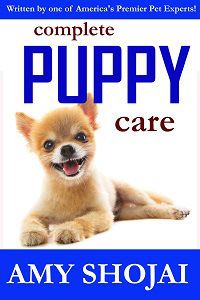 Learn more about your baby dog in the book COMPLETE PUPPY CARE.
Learn more about your baby dog in the book COMPLETE PUPPY CARE.
I love hearing from you, so please share comments and questions. Do you have an ASK AMY question you’d like answered–click the banner, above. Be sure to visit my PetHealthyStore for paw-some products for your furry wonders! Stay up to date on all the latest just subscribe the blog, “like” me on Facebook, and get a FREE BOOK when you sign up for Pet Peeves newsletter. Stay up to date with the latest book give aways, kewl product offers, and appearances related to my THRILLERS WITH BITE!
April 30, 2015
BULLIES, SHAMING & NEW COVERS FOR LOST & FOUND and HIDE & SEEK
 Today I’m at the OWFI WRITERS CONFERENCE where I’ll be speaking and signing books–and for the first time showing the world the UDATED COVERS for my suspense/thrillers LOST AND FOUND and HIDE AND SEEK.
Today I’m at the OWFI WRITERS CONFERENCE where I’ll be speaking and signing books–and for the first time showing the world the UDATED COVERS for my suspense/thrillers LOST AND FOUND and HIDE AND SEEK.
I love the new look! What do you think? The third book in the series, SHOW AND TELL follows this new theme. Stay tuned for that cover reveal soon, with another NAME THAT DOG/NAME THAT CAT contest for the animal characters. While all three books are pet-centric with an animal behaviorist hero and service dog viewpoint, my editor and publisher and I believe these new covers will appeal beyond dog and cat loving audience. The timing is good, too, right before the third book comes out.
Many of y’all know that I’ve been in the process of updating the nonfiction book covers–you can see them in the sidebar over there on the right—->. They needed it; styles change, and some of the covers just didn’t look as good as they could, especially the print versions.
But the facelift happened sooner rather than later because of a situation from a couple of weeks ago specific to my HIDE AND SEEK “old cover.” This situation was hurtful, embarrassed and insulted me and my publisher and also angered me. I debated whether to talk about this publicly but…for many reasons, have decided to explain what happened. Scroll on down and I’ll give you the back story about why the covers have been changed.
 I very much liked the “old” covers of my suspense novels. My editor and I went through dozens of versions and even asked Facebook friends for input. Both of the old version of the covers featured a dog–a real life dog that I know–as the “cover model” and it was great fun to highlight that wonderful canine. The HIDE AND SEEK cover also included a cat, because–well, that’s intrinsic to the story and readers demanded it!
I very much liked the “old” covers of my suspense novels. My editor and I went through dozens of versions and even asked Facebook friends for input. Both of the old version of the covers featured a dog–a real life dog that I know–as the “cover model” and it was great fun to highlight that wonderful canine. The HIDE AND SEEK cover also included a cat, because–well, that’s intrinsic to the story and readers demanded it!
Yes, I listen to readers. I feel like we’re business partners so I want y’all to be happy.
So I hope you’ll understand why the pictures of the dog viewpoint character Shadow and the Maine Coon cat Macy have been removed to give the covers a more suspenseful look. You see, covers that feature dogs and cats tend to be thought of as more “cozy mysteries” and…well, these ain’t cozy and tend toward the thriller realm.
BULLIES & WRITERS
I’ve been fortunate in reviews of my books–I know other authors have had issues with “bullies” so it was a new experience for me. Here’s what happened.
My cover (old version) of HIDE AND SEEK was anonymously sent to an online “shame” site that invited anyone to make fun of poorly designed book covers. Now, I’ve been in this writing and publishing game for longer than I care to say, and to survive you need a bit of a thick skin. Having one of my books called a “kindle cover disaster” felt personal, for reasons I’ll explain below. Further, while other covers/comments did poke fun, with my book the submitter described the title font in decidedly unsavory, even lewd tones.
Really? Someone felt that strongly about a font on my book that they felt compelled to make rude comments and invite others to join in–and boy, did they join in! As a result, that “shaming” thread got shared all over the internet with my “terrible cover” headlining articles overseas, re-posted on blogs, and additional unkind references made to the wonderful, caring professional writer who shared a cover quote on the book, Dr. Lorie Huston, because of her association with the Cat Writers Association.
That’s not the first time that mention of CWA raised eyebrows. The organization has been around 20+ years and members must be published to qualify for membership. If you read cat books or articles or view cat videos or pictures, chances are the work comes from a CWA member.
At the time she gave me the endorsement, Dr. Lorie was president of our Cat Writers Association. So these comments hurt me more than anything others might say about the cover design, because Dr. Lorie passed away last year. The CWA website got nearly 300 “hits” as a result, with people making fun of her, the organization, my cover, and then were vastly disappointed that it wasn’t the cats writing the books.  Nope, the cats (and dogs) just inspire the work. Don’t tell my furry crew, they truly believe they are the authors!
Nope, the cats (and dogs) just inspire the work. Don’t tell my furry crew, they truly believe they are the authors!
What flabbergasted me was Dr. Lorie’s quote only appeared on the cover of my book prior to the book’s release. It had been moved to the BACK of the cover after the wonderful J.T. Ellison also offered an endorsement, which you can see on the new cover, above, as well.
People must have way too much time on their hands. Yes, it hurt and it still hurts. And it makes me also hurt for the dozens of others listed in that shame-posting who maybe had published their one-and-only book, and now will never take that chance again.
Were some of the posts and comments funny? Well, yes. One fellow actually loved the attention and sold a bunch of books, declaring his cover was supposed to be funny–so good for him!
Was my book cover terrible? I don’t think so but it could have been better–and now it is vastly improved to fit in the mystery/suspense genre. So in a way, whoever wanted to hurt me actually provided a great service. So whoever you are, thank you.
I hadn’t planned to say anything, because frankly, it’s still embarrassing to know that there was probably truth in the criticism. Authors and even editors and publishers may be too close to see such things–I’ve learned a valuable lesson.
And I’m done crying, done with red-face hurt, and done with the anger. I’m revealing more than new covers here because 1) this is part of the biz so I gotta own it, 2) newer writers need to know this crappiocca happens to EVERYONE, and 3) I hate letting bullies win.
Besides, as they say, there’s no such thing as “bad publicity” only “publicity” so maybe it’ll sell an extra book or three. 
Has anything like this ever happened to you? How did you handle it? Were they right? Did you make “lemonade?” Do tell!
I love hearing from you, so please share comments and questions. Do you have an ASK AMY question you’d like answered–lick the banner, above. Be sure to visit my PetHealthyStore for paw-some products for your furry wonders! Stay up to date on all the latest just subscribe the blog, “like” me on Facebook, and get a FREE BOOK when you sign up for Pet Peeves newsletter. Stay up to date with the latest book give aways, kewl product offers, and appearances related to my THRILLERS WITH BITE!
April 29, 2015
Pet Rescue Breathing & CPR Saves Cat & Dog Lives
 Did you know that April is First Aid Awareness Month? You can save your dog or cat’s life by knowing how to do pet CPR and how to perform rescue breathing. Pets suffer brain injury and death if oxygen is cut off for only a few minutes. When minutes count, rescue breathing can save your pet’s life.
Did you know that April is First Aid Awareness Month? You can save your dog or cat’s life by knowing how to do pet CPR and how to perform rescue breathing. Pets suffer brain injury and death if oxygen is cut off for only a few minutes. When minutes count, rescue breathing can save your pet’s life.
How To Perform Pet Rescue Breathing
First check to be sure nothing blocks the airway before you begin. Cradle small cats, puppies and dogs in your lap, but lay a large dog on the floor on his side. Straighten his neck by lifting his chin. The airway must be a straight shot into the lungs to ensure your breath is not blocked.
Muzzles won’t seal well enough for mouth-to-mouth breathing to work. Instead, hold his mouth closed with one or both hands to seal his lips. Then place your mouth entirely over his nose. Your mouth will cover both the mouth and nose of most small pets, and for large dogs may simply cover his nose.
Blow two quick breaths just hard enough to move his sides, and watch to see if his chest expands. Blowing into his nose directs air to the lungs when the lips are properly sealed. For small pets, think of blowing up a paper bag—gently does it!—or you could over-inflate and damage the lungs. However, you’ll need to blow pretty hard to expand the lungs of larger dogs.
Between breaths, pull your mouth away to let the air naturally escape before giving another breath. Continue rescue breathing at a rate of 15 to 20 breaths per minute until he starts breathing on his own, or you reach the veterinary clinic.
How to Give Pets CPR
Pets CPR combines rescue breathing with external heart compressions, and stands for cardiopulmonary resuscitation. The compressions help the blood move through the body even though the heart has stopped. To perform CPR on your puppy, alternate rescue breathing with chest compressions, giving one breath for every five compressions for any size puppy. It’s most effective to have one person handle the breathing while a second person performs the compressions. Continue CPR until you reach the veterinary clinic or your pet revives, whichever comes first.
Determine your puppy’s heart has stopped by listening with your ear flat to her side directly behind the left elbow, or feel the place with the flat of your hand. If you still can’t tell for sure, use the blink test. Tap her closed eyelid. Even unconscious pups will blink unless the heart has stopped, so if there’s no movement, start CPR immediately.
For Pets Under 20 Pounds
The size of the puppy and his body conformation rules how you administer CPR. For puppies under 20 pounds, perform the cardiac pump technique with compressions over the heart. That squeezes the motionless heart so that it pumps blood. Veterinarians recommend 100 to 120 compressions each minute, of 1/3rd to 1/2 of the chest width, according to the latest veterinary guidelines. It’s also highly recommended to perform CPR in 2-minute cycles, and switch who does the compressor in each cycle, so you don’t wear yourself out.
Find the heart by flexing your pup’s front left foreleg backwards. The center of the heart falls directly beneath where the point of the elbow crosses her chest.
Situate your puppy on her right side on a flat, firm surface. Cup your hand over the heart, and squeeze firmly. Press in about ½ inch with your thumb on one side and fingers on the other.
For very small puppies that fit in the palm of your hand, perform compressions between your fingers. Cradle her in the palm of your hand, with your thumb over the heart and fingers on the other side, and squeeze rhythmically.
For Pets Over 20 Pounds
Once the pup weighs more than 20 pounds, the space between the strong ribs and heart interfere with successful compressions. So instead, pups this size best benefit from the thoracic pump method. When she’s on her side, place your hands over the highest part of the chest and compress. That changes the chest cavity interior pressure which can move blood forward. Place one hand flat on her chest, and the other over top of the first hand, and press down 30 to 50 percent.
Barrel chested puppies like Bulldogs should be placed on their back before compressing the chest. Cross her paws over the breast, and kneel with her between your legs—tummy up. Hold her paws and perform compressions downward directly over the breastbone.
Needling For Life
When the pet’s breathing and heart has stopped and resuscitation methods have failed, veterinarians suggest stimulating an acupuncture “alarm point.” That prompts the body to release natural adrenaline (epinephrine), a drug commonly used in human and veterinary medicine in cardiac arrests to stimulate the heart and breathing.
The alarm point is in the center (midway point) of the slit found between your puppy’s nose and upper lip. Stick a needle, safety pin, paperclip, or even your clean fingernail into this point. Jab deeply to the bone, and repeatedly wiggle back and forth.
Don’t be squeamish—this is your puppy’s life you hold in your hands! Continue administering the emergency acupuncture treathttp://amyshojai.com/wp-admin/post.ph... for at least twenty minutes, until the pet revives or you reach the hospital.
Puppies and kittens dead at birth treated with this method have been revived more than an hour later, and survived to live long, healthy lives. A needle jab, with rescue breathing, can ensure your puppy survives.
For more information about first aid that can save your pet’s life, refer to The First Aid Companion for Dogs & Cats.
I love hearing from you, so please share comments and questions. Do you have an ASK AMY question you’d like answered–lick the banner, above. Be sure to visit my PetHealthyStore for paw-some products for your furry wonders! Stay up to date on all the latest just subscribe the blog, “like” me on Facebook, and get a FREE BOOK when you sign up for Pet Peeves newsletter. Stay up to date with the latest book give aways, kewl product offers, and appearances related to my THRILLERS WITH BITE!
April 27, 2015
DOG FLU, EMERGENCY! Wait…really?

Image Courtesy of DepositPhotos.com
On May 2, Denison honors and celebrates hero dogs with a fun day at Heritage Park, with vendors, blessing of the dogs, food and even adoption events. There’s a parade with military hero theme, lots of contests like retrieving, dachshund races, obedience, dress-up, and talent. I’ve attended as a judge in the past, and it’s great fun for the entire family, including the dog.
I spoke with local veterinarian Dr. Clay Morris of Brakebill Veterinary Hospital about precautions when you take your pet out-and-about to such events. Very young, very old, and immunocompromised dogs are at most risk for contracting any infectious illness, so be sure your pooch is protected.
“Dogs don’t interact like people, riding the bus every day and going to work,” he says, so they’re not as likely to be exposed or transmit illness as people. Be sure your dog is protected against the most common dangers like Parvo and distemper with proper vaccinations.
What about dog flu? “We’ve had no cases at all, luckily,” says Dr. Morris. “Area veterinarians are certainly monitoring the situation.” He assured me that clients will be notified of any change in status but right now dog flu is not a concern in our area. “Specialists tell us the virus is a localized outbreak currently limited to the Chicago area.”
Of course, that’s good for us, not so good for Chicago pet parents. Here’s the information you need to know.
DOG FLU IN THE NEWS
Approximately 1000 dogs have been affected by the Chicago-area outbreak of canine infectious respiratory disease (CIRD) caused by canine influenza. While it is serious for dogs that are affected, the news media has latched onto this “sexy” story and spread it farther than the virus itself is likely to be able to travel.
Dr. Patrick Mahaney, a contributor to www.petMD.com, and other expert sources like Cornell University and its New York State Animal Diagnostic Laboratory, have shared basic information about this disease.
TWO DIFFERENT VIRUSES INVOLVED
Just as with people, there are different kinds of flu that affect animals. Canine influenza A (H3N8) virus is closely related to a common flu virus that has been found in horses for more than 40 years. It’s thought that the virus mutated and became infectious to dogs, with first reported outbreak ten years ago in 2004 in Greyhounds. Today, H3N8 is considered a dog-specific canine flu.
The Chicago outbreak of dog flu is caused by a newer strain. This is the first appearance of Influenza A H3N2 strain of the virus in North America; however, it was first detected in 2007 in dogs in South Korea.
It’s thought that this a “bird flu” adapted to affect dogs, and canine H3N2 virus has since been reported in China and Thailand where it reportedly can affect cats as well as dogs. However, studies indicate that neither virus transmits well to other companion animal species. Further, it is different from human seasonal H3N2 viruses. There have been no reports of dog-to-human transmission, and it is not considered contagious to people.
HOW DOGS CATCH FLU
Dog flu is highly contagious between dogs. Nearly 100% of dogs exposed to the virus get it–but not all get sick. The virus is spread through direct contact with bodily fluids—sneezing, coughing, sniffing, licking.
Stress caused by travel, confinement or interaction with strange dogs, for example increases your dog’s susceptibility. “Environments that promote canine congregation – such as boarding facilities and dog parks – are also hot zones for various diseases,” says Dr. Mahaney.
SIGNS OF DOG FLU
Both strains of dog flu can cause high fever, loss of appetite, coughing, nasal discharge, and lethargy. Some dogs develop red or runny eyes, and in most cases, there’s a history of contact with other sick or “carrier” dogs.
MILD FORM: Dogs with mild symptoms may have a “wet” cough (resembling “kennel cough”) with nasal discharge. In mild cases, these signs last 10 to 30 days and usually go away on their own. Cough suppressants and/or antibiotics may be prescribed if a secondary bacterial infection exists. According to Cornell, some infected dogs won’t show signs at all (some experts say probably 20% are asymptomatic)—however, they are still contagious and can spread the disease.
SEVERE FORM: Symptoms may be more severe in cases caused by the H3N2 virus. Signs may be a high sudden fever (above 104 degrees Fahrenheit), followed by hemorrhagic pneumonia, coughing up blood and difficulty breathing. Illness can be complicated with bacterial pneumonia. Hospitalization with aggressive treatment with antibiotics, fluids are vital. Isolation to protect other dogs from contracting the disease is important.
DIAGNOSING & PREVENTION CHALLENGE
Diagnosis is based on symptoms and a battery of tests that may include blood analysis, lung Xrays, and microscopic examination of samples from the lungs. There is a specific test available for the dog flu, but not the new variant. Cornell advises veterinarians that the Rt-PCR test may detect Influenza A H3N8, but the H3N2 may not be detected. However, an H3N2-specific serologic assay is under development and will be available soon.
Dr. Mahaney notes that a vaccine (Nobivac® Canine Flu H3N8) is available. Again, it isn’t known if this will also protect against the H3N2 strain. Your veterinarian will advise you best whether the vaccination is a good idea for your dog. In areas like Chicago where the viruses are active, avoid places where dogs congregate, such as dog parks and grooming salons.
Again, no cases have been reported in my neck of the woods here in North Texas. So for those attending the Denison event next Saturday, just be sure your pet is healthy, on a leash, and has proof of current vaccinations. For very young, very old or immune-challenged pets, leave them home while you enjoy the day! For details, visit DenisonLive.com.
For more information about dog flu, refer to these links:
Steve Dale’s Pet World, Chicago Now Blog
CDC’s Key Facts about Canine Influenza (Dog Flu)
The American Veterinary Medical Association (AVMA) Canine Influenza FAQ
I love hearing from you, so please share comments and questions. Do you have an ASK AMY question you’d like answered–lick the banner, above. Be sure to visit my PetHealthyStore for paw-some products for your furry wonders! Stay up to date on all the latest just subscribe the blog, “like” me onFacebook, and get a FREE BOOK when you sign up for Pet Peeves newsletter. Stay up to date with the latest book give aways, kewl product offers, and appearances related to my THRILLERS WITH BITE!

